Related Research Articles
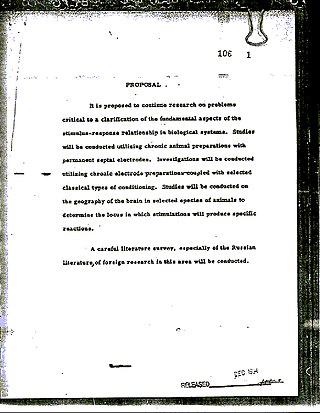
Project MKUltra was an illegal human experiments program designed and undertaken by the U.S. Central Intelligence Agency (CIA) to develop procedures and identify drugs that could be used during interrogations to weaken people and force confessions through brainwashing and psychological torture. It began in 1953 and was halted in 1973. MKUltra used numerous methods to manipulate its subjects' mental states and brain functions, such as the covert administration of high doses of psychoactive drugs and other chemicals without the subjects' consent, electroshocks, hypnosis, sensory deprivation, isolation, verbal and sexual abuse, and other forms of torture.

John Cunningham Lilly was an American physician, neuroscientist, psychoanalyst, psychonaut, philosopher, writer and inventor. He was a member of a group of counterculture thinkers that included Timothy Leary, Ram Dass, and Werner Erhard, all frequent visitors to the Lilly home. He often stirred controversy, especially among mainstream scientists.
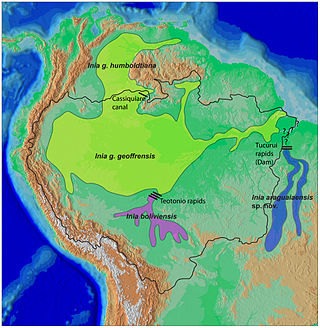
River dolphins are a polyphyletic group of fully aquatic mammals that reside exclusively in freshwater or brackish water. They are an informal grouping of dolphins, which itself is a paraphyletic group within the infraorder Cetacea. Extant river dolphins are placed in two superfamilies, Platanistoidea and Inioidea. They comprise the families Platanistidae, the recently extinct Lipotidae, Iniidae and Pontoporiidae. There are five extant species of river dolphins. River dolphins, alongside other cetaceans, belong to the clade Artiodactyla, with even-toed ungulates, and their closest living relatives the hippopotamuses, from which they diverged about 40 million years ago. Specific types of dolphins can be pink.
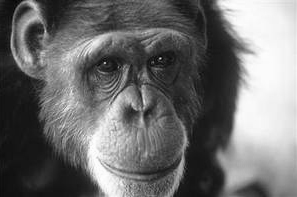
Washoe was a female common chimpanzee who was the first non-human to learn to communicate using American Sign Language (ASL) as part of an animal research experiment on animal language acquisition.
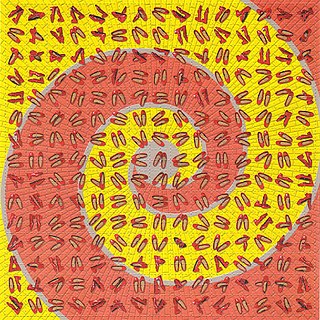
The psychedelic drug lysergic acid diethylamide (LSD) was first synthesized on November 16, 1938, by the Swiss chemist Albert Hofmann in the Sandoz laboratories in Basel, Switzerland. It was not until five years later on April 19, 1943, that the psychedelic properties were found. Today, the discovery of LSD is celebrated worldwide during the annual Bicycle Day holiday, serving also as the day celebrating the psychedelic revolution in general.
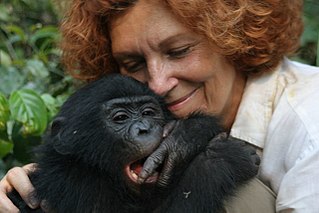
Human–animal communication is the communication observed between humans and other animals, ranging from non-verbal cues and vocalizations to the use of language.
Operation Midnight Climax was an operation carried out by the CIA as a sub-project of Project MKUltra, the mind-control research program that began in the 1950s. It was initially established in 1954 by Sidney Gottlieb and placed under the direction of the Federal Bureau of Narcotics in Boston, Massachusetts with the "Federal Narcotics Agent and CIA consultant" George Hunter White under the pseudonym of Morgan Hall. Dr. Sidney Gottlieb was a chemist who was chief of the Chemical Division of the Office of Technical Service of the CIA. Gottlieb based his plan for Project MKUltra and Operation Midnight Climax off of interrogation method research under Project Artichoke. Unlike Project Artichoke, Operation Midnight Climax gave Gottlieb permission to test drugs on unknowing citizens, which made way for the legacy of this operation. Hundreds of federal agents, field operatives, and scientists worked on these programs before they were shut down in the 1960s.
Christopher Riley is a British writer, broadcaster and film maker specialising in the history of science. He has a PhD from Imperial College, University of London where he pioneered the use of digital elevation models in the study of mountain range geomorphology and evolution. He makes frequent appearances on British television and radio, broadcasting mainly on space flight, astronomy and planetary science and was visiting professor of science and media at the University of Lincoln between 2011 and 2021.

The popularity of swimming with dolphins increased in the 1980s and 1990s, occurring in over 65 countries, both as a form of therapy as well as a tourist activity. Proponents of dolphin-assisted therapy (DAT) say that interacting with dolphins can help to treat mental and physical disorders in humans, but there is limited clinical evidence proving its benefits. Marine parks and other tourist destinations offering "swim-with-dolphin" experiences have also promoted the purported healing attributes of dolphins. Opponents argue that interactions between humans and dolphins have had a negative impact on dolphin populations both in the wild and in captivity, and that the practice can be dangerous for humans. Concerns over animal welfare have led to bans on swimming with dolphins in Costa Rica, as well as certain locations in New Zealand and Hawaii.
A talking animal or speaking animal is any non-human animal that can produce sounds or gestures resembling those of a human language. Several species or groups of animals have developed forms of communication which superficially resemble verbal language, however, these usually are not considered a language because they lack one or more of the defining characteristics, e.g. grammar, syntax, recursion, and displacement. Researchers have been successful in teaching some animals to make gestures similar to sign language, although whether this should be considered a language has been disputed.

Planète Sauvage is a zoological park situated in the French Atlantic coast, in Port-Saint-Père near Nantes, in the Loire-Atlantique departement. Founded in 1992 by Monique and Dany Laurent and known as the Safari Africain until 1998, it was then operated by the Compagnie des Alpes between 2005 and 2015. Since that date the park has been the property of the multinational company Looping Group, whose main shareholder is a Belgian private equity fund of the Groupe Bruxelles Lambert. Its director is Philippe Vignaud.
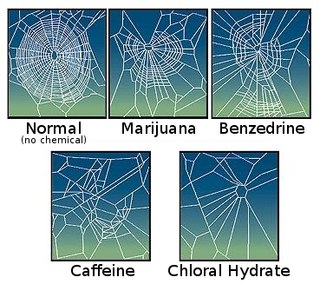
Psychoactive drugs, such as caffeine, amphetamine, mescaline, lysergic acid diethylamide (LSD), cannabis, chloral hydrate, theophylline, IBMX and others, can have strong effects on certain animals. It is believed that plants developed caffeine as a chemical defense against insects.
Animal suicide is when an animal intentionally ends its own life through its actions. It implies a wide range of higher cognitive capacities that experts have been wary to ascribe to nonhuman animals such as a concept of self, death, and future intention. There is currently not enough empirical data on the subject for there to be a consensus among experts. For these reasons, the occurrence of animal suicide is controversial among academics.

The Guatemala syphilis experiments were United States-led human experiments conducted in Guatemala from 1946 to 1948. The experiments were led by physician John Charles Cutler, who also participated in the late stages of the Tuskegee syphilis experiment. Doctors infected 1,300 people, including at least 600 soldiers and people from various impoverished groups with syphilis, gonorrhea, and chancroid, without the informed consent of the subjects. Only 700 of them received treatment. In total, 5,500 people were involved in all research experiments, of whom 83 died by the end of 1953, though it is unknown whether or not the injections were responsible for all these deaths. Serology studies continued through 1953 involving the same vulnerable populations in addition to children from state-run schools, an orphanage, and rural towns. However, the intentional infection of patients ended with the original study.

Tara Melaine Ruttley is Associate Chief Scientist for Microgravity Research at NASA Headquarters in Washington, DC. Prior to this, she was Associate Program Scientist for the International Space Station (ISS) at NASA's Johnson Space Center in Houston, Texas. Until 2007, she was lead hardware engineer for the ISS Health Maintenance System, leading a team of engineers whose job was to provide reliable medical equipment that kept astronauts healthy in orbit. She subsequently served as the lead hardware engineer for the ISS Human Research Facility. She served as an aquanaut on the NASA Extreme Environment Mission Operations 6 crew in July 2004.
The Center for the Advancement of Science in Space (CASIS), a non-profit organization, is the manager of the International Space Station United States National Laboratory, a US government-funded laboratory with principal research facilities located in the United States Orbital Segment of the International Space Station (ISS).

Margot Lee Shetterly is an American nonfiction writer who has also worked in investment banking and media startups. Her first book, Hidden Figures: The American Dream and the Untold Story of the Black Women Who Helped Win the Space Race (2016), is about African-American women mathematicians working at NASA who were instrumental to the success of the United States space program. She sold the movie rights while still working on the book, and it was adapted as a feature film of the same name, Hidden Figures (2016). For several years Shetterly and her husband lived and worked in Mexico, where they founded and published Inside Mexico, a magazine directed to English-speaking readers.
The Spring Grove Experiment is a series of lysergic acid diethylamide (LSD) studies performed from 1963 to 1976 on patients with psychotic illnesses at the Spring Grove Clinic in Catonsville, Maryland. These patients were sponsored by a federal agency called the National Institute of Mental Health to be part of the first study conducted on the effects of psychedelic drugs on people with schizophrenia. The Spring Grove Experiments were adapted to study the effect of LSD and psychotherapy on patients including alcoholics, heroin addicts, neurotics, and terminally-ill cancer patients. The research done was largely conducted by the members of the Research Unit of Spring Grove State Hospital. Significant contributors to the experiments included Walter Pahnke, Albert Kurland, Sanford Unger, Richard Yensen, Stanislav Grof, William Richards, Francesco Di Leo, and Oliver Lee McCabe. Later, Spring Grove was rebuilt into the Maryland Psychiatric Research Center where studies continued to be performed for the advancement of psychiatric research. This study on LSD is the largest study on psychedelic drugs to date.
Clara Ursitti is a Canadian-Italian artist based in Glasgow, Scotland. She was born in North Bay, Ontario in 1968.
References
- 1 2 3 4 5 6 Riley, Christopher (8 June 2014). "The dolphin who loved me: the Nasa-funded project that went wrong". The Guardian . Retrieved 16 April 2018.
- ↑ "The Girl Who Talked to Dolphins - BBC Four". BBC. Retrieved 16 April 2018.
- ↑ Mosendz, Polly (12 June 2014). "How A Science Experiment Led to Sexual Encounters Between a Woman and a Dolphin". The Atlantic . Retrieved 6 April 2021.
- ↑ "When The Love Story Of A Dolphin And Woman Made News In The 60s". News18 . 19 September 2023. Retrieved 17 February 2024.
- ↑ Riley, Christopher (8 June 2014). "The dolphin who loved me: the Nasa-funded project that went wrong". The Guardian . Retrieved 16 April 2018.
- ↑ Berkowitz, Joe (13 November 2017). "That Amazing "SNL" Dolphin Sketch Is Based On A True Story". Fast Company. Retrieved 24 March 2021.